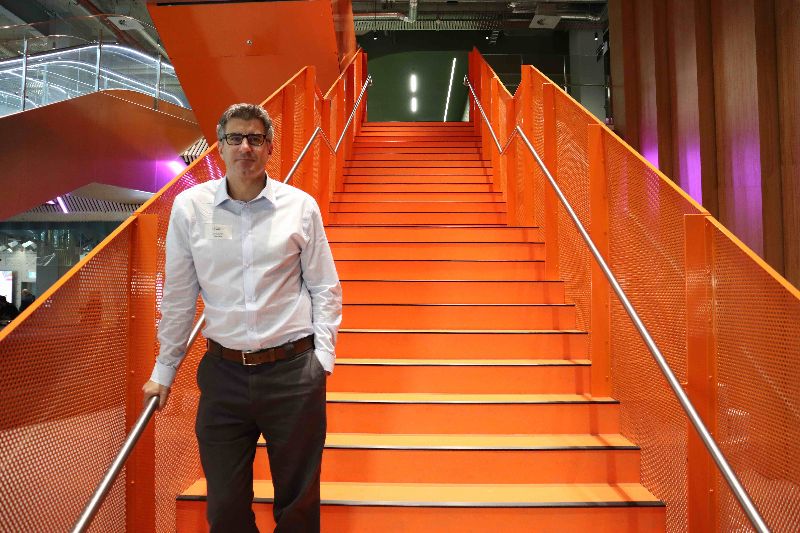

Jaimie Johnston and Bryden Wood’s open-source vision for the construction industry at Building 4.0 CRC’s annual conference.
Held in Melbourne, on 11 October, Building 4.0 CRC’s second annual conference was a unique event in the building innovation ecosystem. “Culture of Innovation” showcased international and national guests, with a mix of presentations, roundtable discussions, demonstrations and exhibitions. (main pic: Bryden Wood’s Jaimie Johnston presenting at Building 4.0’s annual conference.)
At the event, Michael Dolphin, Publisher of Built Offsite, was fortunate to have some one-on-one time to interview one of the event’s presenters, Jaimie Johnston MBE, Board Director and Head of Global Systems of Bryden Wood.
Jaimie Johnston is a key figure at global consultancy Bryden Wood, an innovative design and operations consultancy. Joining in 1995 and retaining his employee number one position, throughout his tenure, he has passionately advocated for the transformation of the construction sector through digital design and integrated, technology-driven methods.
The emergence of computer-aided design in the mid-1970s ignited a revolution, fundamentally reshaping architecture and industrial design and manufacturing. The transformative wave of blending these two disciplines, for Jaimie Johnston, underscores a life-long conversation that delves into the integration of industrial manufacturing techniques, architecture, and ultimately, establishing a new open-source DfMA (Design for Manufacturing and Assembly) approach called platforms (or P-DfMA).
“When I was in college, I was really interested in high-tech architects such as Grimshaw’s, RSHP (previously Richard Rogers) and Foster + Partners. When they started, they were trying to design the best buildings they could for the lowest cost, and to achieve this, they were using industrial materials and industrial processes. On one of the Grimshaw projects, the grids were based on what was then the biggest press-break available, in effect, taking a single sheet of material and pressing it into a panel.
“You didn’t have to cut anything, and you had complete standardisation. It’s that sort of stuff that really interested me when I was studying architecture,” says Jaimie.
In 1995, driven by their interest in technology and manufacturing processes from their experiences at Grimshaw Architects in London, Mark Bryden and Martin Wood met and founded Bryden Wood.
During his student days, Jaimie was hired as the company’s first employee.
“Martin knew the head of the architecture school at Sheffield University, he spoke with her and said, ‘We’re looking for a person with these characteristics. Who have you got?’ And she said, ‘You want to talk to this guy.’ So, Martin rang me, I went to London for an interview, and started work that afternoon. Mark and Martin loved the ‘appropriation’ of industrial techniques into architecture, and so Bryden Wood was established to further that vision.”
Bryden Wood’s inception closely aligned with the release of a report by the UK Government called “Constructing the Team” by Sir Michael Latham. This report highlighted various shortcomings in the UK construction industry. Four years later, in November 1998, the Egan Report titled “Rethinking Construction” was released, spearheaded by an industry task force led by Sir John Egan. Both these reports, particularly when considered together, played a role in promoting efficiency improvements in the UK construction industry practices in the early 21st century.
Commenting on that period, Jaimie said, “we naively thought these reports would trigger a complete change towards industrialisation, and we got ahead of what we thought was going to be a massive wave of innovation. It turned out no one else did, and it was just us for a while. However, it did lead us to establishing design disciplines that recognised the importance of integration.”
Bryden Wood started working on data centres in 1998, intensifying their efforts by 2000 during the pre-dot com bubble era. During this period, they aimed to standardise and simplify the complexity of data centres. Their work expanded to include aviation projects, especially for BAA (now known as Heathrow Airport Holdings), because of their interest in componentised structures and the time constraints of working at airports, which made prefabrication an attractive solution.
While Bryden Wood excelled in complex environments like airports, they believed their methods could be even more effective in simpler settings. However, breaking into other sectors, like healthcare, proved challenging, as potential clients sought proven experience in those specific fields.
Following this period, Bryden Wood began prototyping designs that were technically feasible but lacked market interest. “Martin [Wood] described it as like taking clients into the dark woods,” said Jaimie.
To demonstrate their concepts, they started creating physical prototypes. By 2006, they established their own factory, designing and producing a timber-based system for primary schools. Over eight years, Bryden Wood constructed about 40 schools using the factory as a prototyping centre, while also conceptualising systems for secondary schools.
Their venture into various sectors revealed that transitioning from data centres was challenging. They found an opportunity to expand into the pharmaceuticals sector, partnering with GSK (GlaxoSmithKline), which eventually led them to healthcare projects with Circle Health Group, a private health care provider in the UK.
Around this time, they also began engaging with the UK Government.

P-DfMA is an approach developed by Bryden Wood to construction and design that integrates principles from manufacturing and production systems. It emphasises standardisation and the use of pre-designed and pre-manufactured components that can be assembled onsite. The “platform” in P-DfMA refers to a set of standardised components or systems, akin to a “kit of parts”, which can be used across multiple projects.
When P-DfMA began, Bryden Wood was already working on detailed component models.
Around 2010-11, when building information modelling (BIM) emerged, the UK Government sought experts for their BIM task group, and Bryden Wood’s work caught their attention.
While engaged in BIM’s early stages, they emphasised to the government that BIM was just the starting point. The Ministry of Justice (MOJ), under Terry Stocks’ leadership, became the pioneer department in this venture.
Stocks, impressed by Bryden Wood’s previous projects, saw potential for BIM implementation in the MOJ. Their proposed approach was to standardise digital and physical components, specifically for prison cell blocks. The MOJ later released a tender focusing on DFMA client engagement, and Bryden Wood won the tender.
Jaimie remarked, “Terry was doing the BIM stuff and helping MOJ develop their BIM implementation strategy. He was saying, ‘I can see where you’re going with this.’ We were saying, if there’s one building type that would lend itself, standardised and repeatable, it’s prison house blocks.”
The overarching goal was to design a prison that not only contains but also aids in rehabilitation, addressing the £18 billion (AUD $35 billion) cost of re-offending. Bryden Wood’s research over six months involved engaging with various stakeholders, from experts to prisoners, to ensure the new prison model would serve its dual purpose.
Following on from the success of the prison project, Bryden Wood suggested to the Ministry of Justice (MOJ) that they develop a generic “kit of parts” for construction that can be applied across various sectors, such as education and healthcare spaces.
They noticed that many construction projects had typological similarities. The construction industry typically focuses on the uniqueness of each sector, but Bryden Wood argued that looking for commonalities could yield better results.
“If you use the same components across different building types, you have a continual demand and that’s how you suddenly get to manufacturing-like efficiency. So that was the big insight. This is what we suggested that government should be doing,” said Jaimie.
Bryden Wood believed that without the government’s intervention, the construction sector would remain unchanged.
A key plank of Bryden Wood’s philosophy is one of transparency, and their relationship with the UK Government was built on trust.
“The reason we were allowed to have some of the conversations we had with government was because they knew we weren’t trying to commercialise it for Bryden Wood’s benefit,” commented Jaimie.
They believe that the construction industry needs rapid transformation, and the company’s goal is to scale up best practices and propagate them to emerging markets, allowing everyone equal access to their methods and open-source tools.
This approach could also harness existing capacity in factories across the UK, leading to more efficient manufacturing, job creation, and new opportunities suggested Jaimie.
On reflection, Jaimie suggests that Bryden Wood has made some mistakes along the way, and further encouraged others to learn from their experiences rather than repeating the same errors.
“As with any large-scale innovation, we made a whole load of mistakes. What we were trying to say is, ‘look, don’t everyone else make the same mistakes.’ Honestly, come and learn from us and take these things.”
Despite their efforts and proven methods, Jaimie still feels there is still a long way to go for the industry and clients, both public sector and private, to fully embrace a platform approach.
Jaimie says: “We firmly believe that the construction industry should converge on a few platforms for efficiency rather than everyone developing their own, to avoid fragmentation and ensure scalability. A collective approach and a shift in the industry mindset will create a network effect that will finally bring construction into the future, digital era.”
See: https://www.brydenwood.com/
@Jaimie_BW
@BrydenWood
Jaimie Johnston MBE
See: https://building4pointzero.org/
Building 4.0 CRC was established as part of the Australian Government’s Cooperative Research Centre program in 2020.